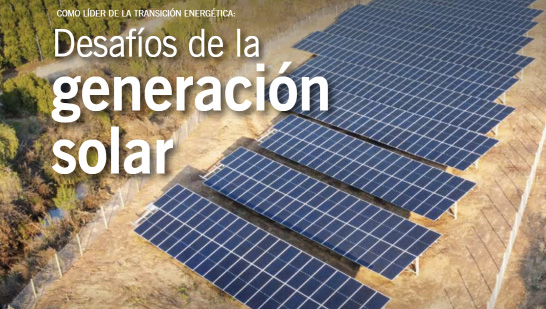
Our director, Ivan Rudnick, commented on the new law promoting electric energy storage and electromobility.
Source: Nueva Minería y Energía Magazine, November 2022.
The new law promoting electric energy storage and electromobility increases the participation of renewable energies, as well as the challenges for electric operators.
By Marina Parisi
When there is no sun or wind, it is impossible for photovoltaic or wind power to inject energy into the electricity system. This lack of power, the result of the intermittency of renewable energies, has triggered the development of storage technologies (batteries), which allow electricity to be stored for use during periods of higher demand, without the need to burn more fossil fuels. Thus, with the aim of increasing the participation of renewable energies and contributing to the decarbonization of the energy matrix, the Senate recently approved the bill that promotes electric energy storage and electromobility. However, some industry players are not entirely satisfied.
Moreover, for Francisco Aguirre, executive director of Electroconsultores, the new regulation “is late because it ignores the technological problems generated by intermittent renewables, which were announced by experts well in advance and have already begun to exert pressure”. But Iván Rudnick, director of Systep Ingeniería y Diseños, challenges Aguirre by emphasizing that “it is not overdue, since the legal initiative reduces the regulatory uncertainty of storage systems, explicitly establishing that they can opt for different forms of remuneration, depending on their size and level of connection to the system. In the consultant’s opinion, the most noteworthy aspect is that now pure storage systems (stand-alone) can participate in the wholesale market, being able to transfer energy “as well as provide sufficiency and receive payments for power. Although the criteria for determining power recognition will be clarified in the regulation of the law, which has not yet been published”.
END-USER BENEFITS
The new law also allows storage systems of up to 9 MW (small means of generation and small means of distributed generation) to choose the stabilized price mechanism for the valuation of their injections into the grid, explains Rudnick. “And at the end-user level, it enables BTM (Behind The Meter) storage systems, including electric vehicles, to inject energy into the grid,” the executive explains, “and the value of this energy can be discounted from monthly electricity tariffs. The new regulation even temporarily reduces the circulation permit for electric cars and establishes new incentives for their purchase, in addition to facilitating new business models based on electromobility.
DECARBONIZATION: NO HURRY, NO PAUSE
Another sector protagonist who considers the new law to be very timely is Eduardo Andrade, executive secretary of Acen (Association of Energy Marketers), who takes the opportunity to demystify the “urgency” in the decarbonization of the energy matrix. “It is relative that there is an urgency to decarbonize. The existing commitment is for 2050, although there are voices interested in advancing the goal to 2030”, the executive specifies. “The prudent thing to do is to move forward with decarbonization, always considering what the cost to the end user is.” We must avoid scenarios in which the early retirement of coal-fired plants translates into more oil-fired generation, with the consequent increase in costs, warns Andrade. “In this context, the new regulation is an additional element that will allow the objective to be achieved in due course.” While the incursion of new players into the storage market is one of the aspects most valued by Javier Tapia, executive director of Transmisoras de Chile. “The new project is positive, long awaited by the entire sector and its momentum will strengthen the system, giving more flexibility, security and competition to the pure storage market.”
In the case of transmission companies, specifies the representative, “it is a very good opportunity to deploy all their experience and knowledge, in an area where it was not possible to participate until now due to legal barriers”.
ECONOMIC OBSTACLES IN SIGHT
While awaiting the publication of the regulation, doubts about the competitiveness and profitability of storage technologies are already looming. This is because there is currently no certainty “whether pure or hybrid storage systems are price competitive with other ‘dispatchable’ technologies, such as gas-fired combined cycle,” says Rudnick. The real problem, warns Aguirre, is that the technological solutions for storage (pumped water, compressed air, flywheels, batteries, superconducting coils) involve a high investment. “This makes the fundamental objective of supply at competitive costs difficult to develop immediately.” But Rudnick applies cooler heads, predicting that economic barriers will gradually diminish as investment costs go down.
CONGESTION IN TRANSMISSION NETWORKS
However, storage systems not only solve the intermittency of renewables, but also prevent part of what is generated by wind and photovoltaic from being discarded. This is due to the congestion of the transmission lines. In fact, between January and October of this year, more than 700 gw/h were lost due to congestion in the transmission networks, according to figures from the Chilean Solar Energy Association (Acesol). For this reason, Tapia asserts that, although the law is very good news for the current scenario (with the gradual and consistent closure of coal-fired units, together with exponential renewable development), “it is crucial to focus the debate on the networks, which so far has not occurred with the necessary sense of urgency or impetus”. “To take advantage of the full potential of storage systems, they must be framed within a comprehensive and long-term planning in the transmission segment,” stresses the spokesperson for Transmisoras de Chile. “This should include the development of new infrastructure works, investments in resilience of existing lines and more encouragement of new technologies.” At this point, the signals and incentives provided by the State will be decisive in promoting investments in technological innovation, concludes Tapia.





